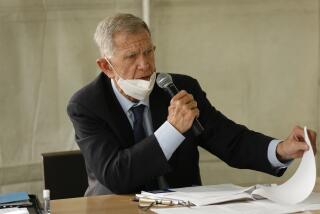Marathon Session Proves One for Books
- Share via
SANTA ANA — What’s blue and gray and costs about $15,000 an hour?
Why, Tuesday’s daylong bankruptcy hearing, of course.
There were lawyers from Little Rock, lawyers from Chicago, lawyers from New York. There were lawyers from the Department of Justice and the state attorney general’s office.
And there were lawyers from virtually every Orange County firm that practices bankruptcy law stuffed into Judge John E. Ryan’s courtroom, their pricey suits shoulder to shoulder in the wooden benches.
Even Will B. King--the local gadfly who attends every Board of Supervisors meeting--stopped by, wearing a fake judicial robe.
The festivities on the 147th day of the largest municipal bankruptcy case were, simply, not to be missed.
“Frankly, I wanted to leave. But one of my clients said it’s a meaningful event so you’ve got to be there,” sighed Marc Winthrop, a $350-an-hour attorney who represents several school districts, while sneaking outside to make some telephone calls. “There’s something to be said for being there for a seminal event.”
According to Margary Culver, deputy in charge of the U.S. Bankruptcy Court in Santa Ana, Tuesday’s event was “a mega-hearing.”
Culver’s work began at 8 a.m., 90 minutes before the hearing was gaveled into order. She and four assistants set up tables outside the front entrance of the Federal Building, handing out color-coded badges to the crowd.
Lawyers who wanted to talk got little red dot stickers--and the best seats inside Ryan’s courtroom. Lawyers who planned to just watch, like Winthrop, got blue. Investment pool participants wore lime green, reporters Kelly green.
Members of the public--mostly people with small individual claims pending against the county--had little orange rectangles, and were relegated to the “overflow rooms,” where they could hear, but not see, what was happening.
Those with orange stickers seemed as confused as the lawyers were comfortable.
“They sent me a letter, so I thought I should show up,” shrugged Ronnie Barquist, a sheet metal worker who is suing the county. He and his wife, Dwanda, trudged to Santa Ana overnight from Las Vegas with their 3-month-old son, Luke. “It’s crazy.”
Doris Forrest knew exactly what she wanted--but had no clue how to get it.
Last September, Forrest’s car was towed while she was visiting Orangewood Children’s Home. They said she’d been parked more than two hours; she insists she wasn’t. Now Forrest wants back the $115 it cost her to get her car.
Her claim--worth less than a third of what Winthrop and at least a dozen other attorneys there Tuesday command in hourly fees--is now stuck in the bankruptcy debacle.
“They have to have respect for people,” Forrest said simply as she wandered the halls of the federal building looking for the right room.
Inside the courtroom, there was a tacit competition to see whose briefcase bulged bigger. Who could use more esoteric verbiage. Who could fulminate longest at the podium without frustrating Ryan enough to send them away empty-handed.
“I know everybody wants to speak,” Ryan said, sounding like an elementary schoolteacher. “But I would appreciate (it) if you would not repeat.”
Though Ryan’s stamp of approval was virtually guaranteed before the hearing began, at least half a dozen attorneys raised lengthy objections to parts of the complex settlement agreement during a three-hour morning session.
They talked about standby note-purchase agreements and taxable note-repayment reserves. They looked at the omnibus reply, and argued over the Phrase Z exclusion. One person’s offset claim was another’s general obligation.
Over and over, they bandied about legalese and acronyms, none more often than “OCIP” (pronounced oh-sip), short for the Orange County Investment Pools.
“What’s OCIP?” one woman whispered to another in the law library, where most members of the public were stashed.
“I don’t know,” said her seatmate. “There’s a lot of things I don’t understand.”
By the 12:15 p.m. lunch break, the major disputes had been resolved. The rest was minutiae. The lawyers were happy.
A cadre of pool participants, and a separate group representing the county’s creditors, ate sandwiches and salads a block from the courthouse at the Boardwalk Cafe. County bankruptcy attorneys Bruce Bennett and Lee Bogdanoff took Patrick Shea, who represents the pool participants committee, to Molly’s, a Cajun-Mexican joint a few doors down.
By 1:30, everybody was back in place, ready for Ryan to return.
Richard Marshack, who bills the official vendors subcommittee $275 an hour, rose at 2 p.m. to say only: “The vendors support the settlement and urge the court to approve it.”
“Some people can’t restrain themselves,” Winthrop said. “We might as well all get in a conga line and wave the thumbs-up and say, ‘Go, judge, you’re doing great.’ ”
But the judge wondered whether it was all going too smoothly.
“You’re awfully quiet,” Ryan said to G. Larry Engel, an attorney who has voiced frequent objections at past court hearings on behalf of cities outside the county with money in the pool. “What’s going on?”
“We’re glad to see the money distributed as quickly as possible,” Engel said after an eruption of laughter died down. “There are people who need the money.”
And then, after a few irked comments from a Merrill Lynch & Co. lawyer that delayed things for 15 minutes, it was over. They slapped each other on the back, and crowded into the elevators.
A jubilant Bennett was wary of joining a full car on its way down.
Jon Schotz, a financial adviser and one of the few non-lawyers in sight, quipped: “It’s only hot air, Bruce.”
More to Read
Sign up for Essential California
The most important California stories and recommendations in your inbox every morning.
You may occasionally receive promotional content from the Los Angeles Times.













